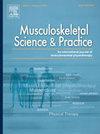物理治疗师如何使用马尾综合征安全网技术,什么影响他们的做法?
IF 2.2
3区 医学
Q1 REHABILITATION
引用次数: 0
摘要
马尾综合征(CES)是一种罕见但严重的神经系统疾病,需要紧急干预以防止永久性伤害。尽管建议使用安全网来降低风险,但它们的应用并不一致,指导或证据有限。现有的研究在很大程度上忽视了CES安全网的具体挑战,特别是在高级物理治疗角色中,如首次接触从业者(fcp)和扩展范围从业者(esp),他们在管理疑似病例中起着关键作用。目的本研究旨在通过探讨MSK物理治疗师在CES安全网方面的经验、信念和实践来解决研究空白,重点关注其对患者和医疗保健系统的影响。方法采用半结构化访谈对8名不同角色的MSK物理治疗师进行定性研究。反身性主题分析用于识别和解释关键主题。结果出现了5个主题:(1)感知焦虑和责任,强调对漏诊的恐惧;(2)沟通和转诊途径方面的挑战,特别是创伤与骨科(T&;O)和事故与急诊(A&;E)部门;(3)受个人因素和环境因素影响,安全防护措施存在差异;(4)模棱两可的CES陈述对决策的影响;(5)系统性障碍,包括转诊途径整合不良和诊断资源有限。本研究独特地强调了CES安全网在高级物理治疗角色中的挑战。需要更明确的指导、跨学科合作和改进的培训来支持临床医生和提高患者的治疗效果。进一步的研究应该调查系统的影响和患者的观点。本文章由计算机程序翻译,如有差异,请以英文原文为准。
How do physiotherapists use Cauda Equina Syndrome safety netting techniques and what influences their practice?
Background
Cauda Equina Syndrome (CES) is a rare but serious neurological condition requiring urgent intervention to prevent permanent harm. Although safety netting practices are recommended to mitigate risks, they are inconsistently applied, with limited guidance or evidence to inform their use. Existing research has largely overlooked the specific challenges of CES safety netting, particularly in advanced physiotherapy roles like First Contact Practitioners (FCPs) and Extended Scope Practitioners (ESPs), who play a pivotal role in managing suspected cases.
Objective
This study aimed to address the research gap by exploring the experiences, beliefs, and practices of MSK physiotherapists regarding CES safety netting, focusing on its impacts on patients and healthcare systems.
Methods
A qualitative study was conducted using semi-structured interviews with eight MSK physiotherapists across various roles. Reflexive thematic analysis was employed to identify and interpret key themes.
Results
Five themes emerged: (1) perceived anxiety and responsibility, emphasising fear of missed diagnoses; (2) challenges with communication and referral pathways, particularly with Trauma and Orthopaedics (T&O) and Accident and Emergency (A&E) departments; (3) variation in safety netting practices, influenced by individual and contextual factors; (4) the impact of ambiguous CES presentations on decision-making; and (5) systemic barriers, including poorly integrated referral pathways and limited diagnostic resources.
Conclusions
This study uniquely highlights the challenges of CES safety netting in advanced physiotherapy roles. Clearer guidance, interdisciplinary collaboration, and improved training are needed to support clinicians and enhance patient outcomes. Further research should investigate systemic impacts and patient perspectives.
求助全文
通过发布文献求助,成功后即可免费获取论文全文。
去求助
来源期刊

Musculoskeletal Science and Practice
Health Professions-Physical Therapy, Sports Therapy and Rehabilitation
CiteScore
4.10
自引率
8.70%
发文量
152
审稿时长
48 days
期刊介绍:
Musculoskeletal Science & Practice, international journal of musculoskeletal physiotherapy, is a peer-reviewed international journal (previously Manual Therapy), publishing high quality original research, review and Masterclass articles that contribute to improving the clinical understanding of appropriate care processes for musculoskeletal disorders. The journal publishes articles that influence or add to the body of evidence on diagnostic and therapeutic processes, patient centered care, guidelines for musculoskeletal therapeutics and theoretical models that support developments in assessment, diagnosis, clinical reasoning and interventions.
 求助内容:
求助内容: 应助结果提醒方式:
应助结果提醒方式:


